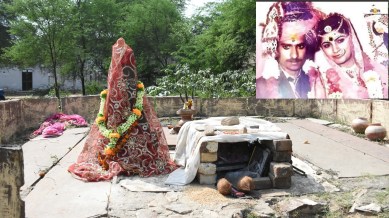Stay updated with the latest - Click here to follow us on Instagram
37 years ago, Roop Kanwar’s death marked India’s last sati case. Now, 8 accused of glorifying the act are acquitted
Court notes that the prosecution could not prove its case beyond doubt

THIRTY-SEVEN YEARS after they were accused of glorifying the death of Roop Kanwar, India’s last known case of sati, a Jaipur special court on Wednesday acquitted eight persons giving them the benefit of doubt.
Along with several others, the eight had allegedly held an event glorifying Roop Kanwar around the first anniversary of her alleged sati act.
Sati Niwaran court special judge Akshi Kansal acquitted Mahendra Singh, Shrawan Singh, Nihal Singh, Jitendra Singh, Uday Singh, Dasrath Singh, Laxman Singh and Bhanwar Singh. All eight were out on bail.
Representing the accused, advocate Aman Chain Singh Shekhawat said, “We are yet to get the detailed order but the court has pronounced its verdict, acquitting eight persons today. The court said that the prosecution could not prove its case beyond doubt, and hence, giving the benefit of doubt to the eight, acquitted them.”
The youngest of six siblings, Roop Kanwar, 18, had married Maal Singh from Divrala in Sikar in January 1987. The marriage was short-lived as Singh died of an illness in a Sikar hospital eight months later. On September 4, 1987, Roop Kanwar is said to have sat on her husband’s funeral pyre and committed sati.
The current case pertains to 1988 when, around the first anniversary of her death, 45 people allegedly held an event glorifying sati. This violated Section 5 (punishment for glorification of sati) of The Commission of Sati (Prevention) Act, 1987, a law that was enacted after Roop Kanwar’s death. The punishment for violation of this section carries imprisonment of up to seven years and a fine of up to Rs 30,000.
“To prove the violation of section 5, section 3 (attempt to commit sati) needed to be proved. However, the prosecution, the investigation agency, could not prove section 3 itself, that sati took place. There was no material evidence which could prove that sati took place and that it was subsequently glorified,” Shekhawat said.
Of the 45 accused in this case, 25 were acquitted in 2004 for lack of evidence, eight were acquitted on Wednesday, four are absconding, while the remaining eight are dead, he said.
“Since the beginning we have been saying that she committed the act on her own and there was no incitement or abetment. No one in the family did anything wrong. And the government too hasn’t been able to prove anything in the courts in 40 years,” Gopal Singh Rathore, Roop Kanwar’s brother, told The Indian Express.
Villagers in Divrala say that on September 4, 1987, after her husband’s death, Roop Kanwar recited the Gayatri Mantra, dressed up in “solah shringaar (16 adornments)” while thousands of people from Divrala and neighbouring villages took out her “shobha yatra” throughout the village, and then committed sati.
The case had led to a public outcry and is also cited as one of the reasons for the ouster of the then Rajasthan chief minister Hari Dev Joshi of the Congress.
Divrala also assumed a special place in Rajput pride, with some of those hailing from the village, adding the name of the village to their own, and parallels were drawn to Chittorgarh’s Padmavati, the one who is said to have jumped into a pyre to escape Alauddin Khilji’s advancing army.